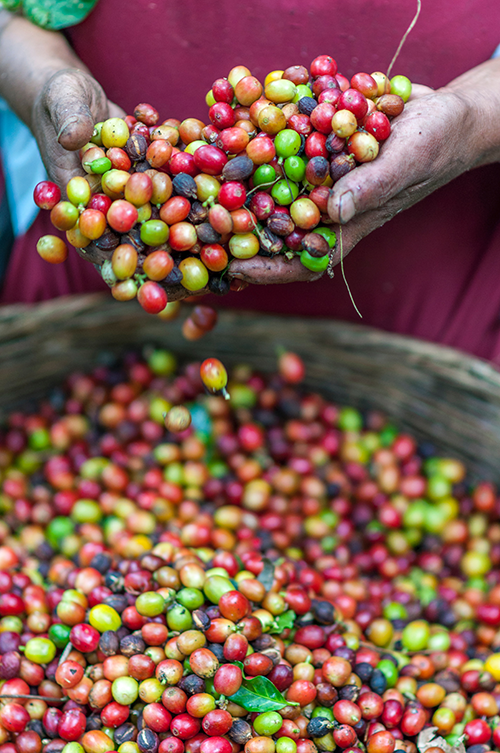
Coffee production is key to the livelihoods of millions of farmers and workers across the tropics. However, while coffee retail has become a high-profile international business, many coffee producers live in poverty and are struggling to respond to environmental change. Although sustainability in coffee production systems can be enhanced through the integration of shade trees, it has long been assumed that this comes at the expense of maximising yields and profitability. However, new research suggests the relationship is more complex.
The project, ‘Sustainability-Intensification trade-offs in Coffee Agroforestry in Central America’, led by Jeremy Haggar, Professor of Agroecology at NRI, is now publishing its main findings. In these countries, coffee is traditionally produced in shaded agroforestry systems, but there is considerable variation in the characteristics of these systems. With research partners, the Tropical Agricultural Research and Higher Education Centre (CATIE) in Costa Rica and the University of Valle in Guatemala, about 180 farms were surveyed in the main coffee growing regions of each country. Initial analysis conducted by Prof Haggar and others indicated that contrary to expectation, the most productive farms still maintained moderate levels of shade. Amongst lower input farms those that had little shade had lower productivity than farms with higher levels of shade.
Based on the farm survey data on coffee production costs, models of farm net cash income were developed by Dr. Baqir Lalani, Senior Fellow in the Economics of Agri-food systems at NRI. Under a base case scenario, no production system generated a living income for the land-size of the average coffee farmer in Costa Rica or Guatemala. The results indicated that the highest net cash income from coffee production was from farms with a combination of high agronomic investment with medium levels of shade from agroforestry trees. While the highly shaded, low investment farms still managed a positive cash income, the low shade, low investment farms failed to cover their costs of production. These differences were maintained under most cost and price scenarios tested, except when coffee prices fell by 50% when all coffee farmers generated net cash losses. However, the highly shaded, low investment farms had the smallest net cash losses. A rise in coffee prices of 50% from base (which briefly occurred in 2021/22) enabled the more intensive farmers to achieve a living income. However, these farmers were also more vulnerable to falling coffee prices. The modelled levels of variation are very likely to be experienced by coffee farmers as fluctuations during a typical coffee production cycle of 20 years can see coffee prices half or double.

‘These complex relationships between agronomic investment, shade and profitability explain why in practice we see many farmers maintaining high shade coffee production systems even though they may be seen as less economically productive. They require less investment and are less vulnerable to extremes of coffee prices’, explained Prof Haggar. The best high-investment coffee farmers still maintain shade trees, presumably for the ecosystem services they provide. The results suggest that farmers with low levels of shade are attempting to reduce their costs, but the combination of low shade and low agronomic investment leads to net cash losses under most price and cost conditions. Thus, rather than there being a trade-off between sustainability and profitability, both depend on the ability of farmers to invest in their coffee production.
Environmental research by Stefania Cerretelli, Doctor in Ecology at NRI, assessing the importance of shade production, indicated how maintenance of high vegetation cover in coffee agroforestry could reduce soil erosion rates by 7-8% over current conditions. It also revealed that universal application of soil conservation practices could reduce soil erosion by a further 11% in Costa Rica and 35% in Guatemala. Further improvements made to a coffee agroforestry model have enabled us to estimate changes in carbon stocks, nitrogen losses and emissions, essential to estimating the greenhouse gas balance of coffee production.
Related research led by Dr Conor Walsh, Environmental Scientist at NRI, estimated the carbon footprint of the agronomic management of coffee. He demonstrated that although more coffee is produced as nitrogen fertilizer applications rise, the embedded greenhouse gas emissions from that fertilizer rise more quickly, increasing the carbon footprint per kilogram of coffee. These emissions can be offset by the carbon sequestered in the soil and by growth of trees and coffee plants. ‘We estimate that for some coffee farms this is indeed the case, but there is also a significant group of farms whose emissions are higher than the carbon sequestered,’ said Dr Walsh. In general, farms with carbon positive coffee production have high levels of shade from trees and moderate application rates of nitrogen. Conversely, carbon negative farms – with net emissions above zero –tend to have low shade and higher rates of nitrogen fertilizer, but also have higher net cash income. Ultimately there does appear to be a trade-off between climate neutral coffee production and incomes farmers can achieve. Results are being shared with stakeholders in Guatemala and Costa Rica who are developing climate neutral strategies for coffee production and marketing.
Partners and funders
The project, ‘Sustainability-Intensification trade-offs in Coffee Agroforestry in Central America’ was funded by BBSRC/GCRF from 2019- 2021.

